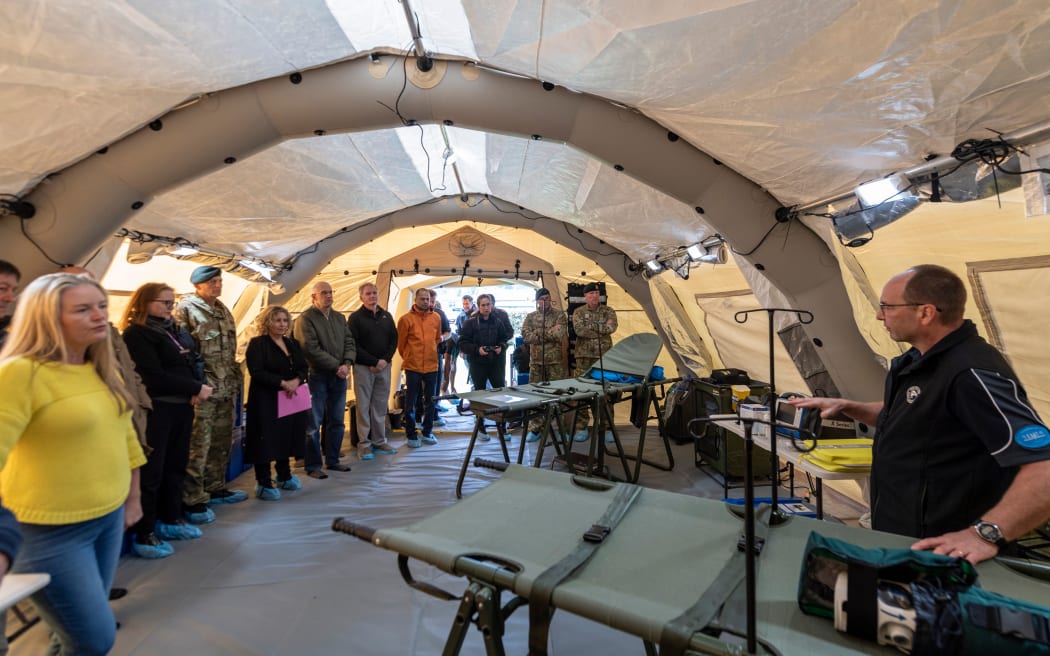
The New Zealand Medical Assistance Team's Dr Alan Goodey explaining the inner workings of the triage area in the deployable health facility setup. 27 October 2023 Trentham Military Base, Upper Hutt, Wellington. Photo: Supplied/New Zealand Defence Force
As Vanuatu continues with the recovery from its third cyclone this year and the top of New Zealand's North Island deals with severe weather from the now ex-cyclone Lola, the New Zealand Medical Assistance Team and the New Zealand Defence Force have combined for the first time to test their response to a potential catastrophic event in Aotearoa.
About 50 personnel from both organisations are taking part in exercise Kotahitanga, which concludes on Thursday this week at Trentham Military Camp in Upper Hutt in Wellington from 24 October to 2 November 2023.
The exercise doubles as a World Health Organisation (WHO) assessment that the teams are operating to international standards and Pacific nations observers from Samoa, Fiji and also Australia are taking part.
Setting up the deployable health facility took place last week with the capital doing its bit to properly simulate wet and windy conditions for all involved.
But they were more than up to the challenge with the commander of the joint support group, New Zealand Defence Force (NZDF) Colonel Anthony Blythen saying it was a welcome opportunity to test themselves.
"It's all about trying to learn what each other's capabilities are and how those capabilities may have opportunities to work together but also to understand where they may not be compatible," Blythen said.
Up to this point, the NZDF and the Ministry of Health have been working independently to develop their operational preparedness for disasters.
Director general of health Diana Sarfati said seeing the combined response capability inspires confidence.
"It is always amazing to see it [deployable health facility] all out at the same time but at the same time if you are delivering high-level healthcare there is always going to be a lot of equipment involved," Sarfati said.
"It gives me a lot of peace of mind to know that there are prepared and trained to be able to respond if we do have a catastrophic event in New Zealand."
Advantages
The impressive deployable health facility set-up is purposely built for a catastrophic event something like a major earthquake within the Hikurangi Trench off the east coast on the North Island.
It weighs a good 18 tonnes and would take two Royal New Zealand Air Force (RNZAF) Hercules flights to deploy, but this has so far never been needed.
However, mobile elements of the set-up and some of the personnel involved are regularly engaged across the country and the wider Pacific region for disasters.
The New Zealand Medical Assistance Team's Dr Alan Goodey is just back from conducting training in the islands and said they are on standby now to assist Vanuatu in its response with Cyclone Lola if required.
"This international effort to have these accredited teams is moving right across the Pacific and there are two advantages to that," Dr Alan Goodey said.
"...one is that the best response is always a local response. And the second is that they also can understand how to receive other medical teams and work together."

Representatives from Fiji and Samoa health and emergency services listen to a presentation by NZDF personnel on a deployable operating theater. The red lights can be switched on and off and are for maintaining a low profile in tactical situations. (Red light travels less far than white light) Photo: RNZ Pacific/ Koroi Hawkins
Fiji, Samoa involved
Representatives from the ministries of health and emergency services of Samoa and Fiji are also taking part in the week long exercise.
Fiji's health emergency co-ordinator Litia Vatuvoka said the learning from the exercise is invaluable for her as she is the logistics lead of the Fiji Emergency Medical Assistance Team and they are working on putting together similar capabilities on a smaller scale.
"We were involved in everything from site-planning to the construction...its amazing and a new experience for me the capabilities that they have and one of the things have noticed is the inter-agency cooperation," Vatuvoka said.
Senior nurse specialist at the Intensive Care Unit of Samoa's main Tupua Tamasese Meaole hospital, Matilda Nofoaiga is said they were still in the early stages of developing their own emergency response capabilities.
She said for now the most valuable thing for them was the gaining knowledge and maintaining these partnerships.
"Yes, that is the main reason: to catch up with their settings and how they maintain things. They all have other jobs, this is their second job and the way I observed them they are all very good team players and their communication is great," Nofaiga said.
The joint response exercise runs up until 6 November.
The New Zealand Medical Assistance Team aims to have renewed its WHO certification that ensures they can be deployed anywhere in the world if required.

